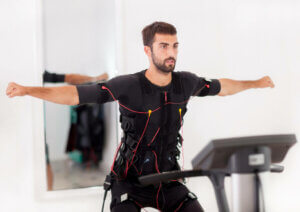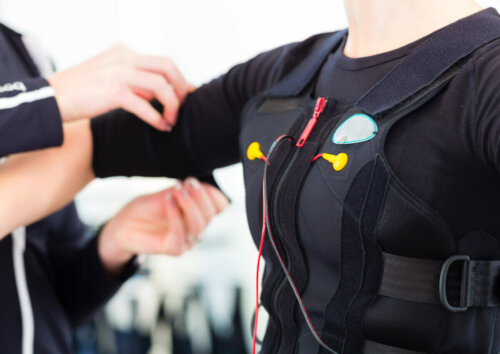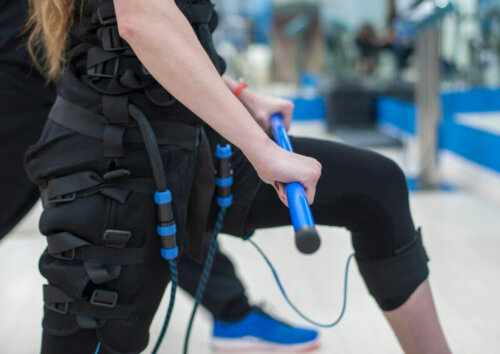5 Potential Benefits of Electrofitness

When it comes to fitness and sports, new innovations are always emerging. An example of this is electrofitness, a discipline that combines electrostimulation with high-intensity training. Despite the fact that not enough scientific literature supports or contraindicates its use, the potential benefits of electrofitness are important. This is because the combination of normal electrostimulation and intense physical exercise is very powerful.
Five potential benefits of electrofitness
That being said, below, you’ll discover the potential benefits of electrofitness training. Nevertheless, you should know that there’s still a lot to investigate and discover.
1. Increased muscle work
As a first benefit, we’re going to talk about the greatest virtue of electrostimulation. When you contract a muscle voluntarily, you only use a certain percentage of it. Therefore, a small percentage isn’t worked. This small percentage is similar to reserves that are only used in emergencies.
Well, when currents are applied to contract the fibers and you also contract them voluntarily, you’re able to use these reserves. It’s a combined contraction that allows you to exert greater force. Therefore, you work the muscle more.
With this in mind, electrofitness allows electrostimulation to be applied to a muscle group instead of only one. Thus, it allows you to improve your strength.

2. Benefits of electrofitness: physical improvement
Due to what we mentioned above, the people who practice electrofitness could experience great physical improvements. As it involves power, the muscles work more, and this is exactly what people who are seeking to build muscle want.
Therefore, with electrofitness, you might be able to achieve physical improvements. Otherwise, these would be difficult to duplicate.
3. Great results in little time
Another interesting fact about electrofitness is that the sessions consist of 20 minutes of intense work. In other words, electrofitness isn’t for aerobic capacity. Instead, it’s focused on increasing explosive strength.
Thus, you must also consider aerobic exercises to improve your aerobic capacity. You have to resort to varied forms of exercise since even the WHO advocates more for aerobic than anaerobic exercises.
Running, cycling, boxing, swimming, or dancing are only a few options. Choose the exercise that you enjoy the most and intersperse aerobic sessions among anaerobic ones! Your heart, as well as other important organs and body parts, will thank you for it.
4. Generalized work
Electrical muscle stimulation (EMS) offers the possibility of working isolated muscles. On the other hand, electrofitness allows you to exercise several areas of your body at the same time.
Electrofitness vests have electrodes that go in the biceps, pectorals, abdominals, trapezius, glutes, and quadriceps. Therefore, it works out many different muscle chains.
Additionally, the use of broad muscle chains allows you to work muscles that traditional exercises don’t. For example, with the electric impulses, you won’t forget to keep your abdomen contracted while doing a certain movement.

5. Benefits of electrofitness: an intense workout in four walls
For professional athletes, this modality simulates conditions that are otherwise difficult to recreate. In other words, it gives them the opportunity to train in a way that would allow them to mimic the harsh conditions of the competition or challenge they’ll have to face.
This is something that professionals are always seeking to improve their performance. In addition, it’s essential to prevent injuries and complete rehabilitation. An athlete must subject their body to the most physically stressful situations of their discipline to ensure that they can endure them. This technique allows them to do it.
Contraindications of electrofitness
Finally, we need to highlight that some groups of people shouldn’t use electrofitness. This includes people with heart disease, those who use pacemakers, children, older adults, and pregnant women.
In addition, it’s contraindicated for people who simply want to lose weight, as aerobic exercise is a much better option, or for people who are just starting to exercise. It’s always advisable to be in a generally good physical shape before trying electrofitness.
Finally, it’s important to note that electrofitness requires medical knowledge and the user must take their physical condition into account. As a result, it should always be done under the supervision of a professional who knows the athlete and is trained to plan these types of routines.
When it comes to fitness and sports, new innovations are always emerging. An example of this is electrofitness, a discipline that combines electrostimulation with high-intensity training. Despite the fact that not enough scientific literature supports or contraindicates its use, the potential benefits of electrofitness are important. This is because the combination of normal electrostimulation and intense physical exercise is very powerful.
Five potential benefits of electrofitness
That being said, below, you’ll discover the potential benefits of electrofitness training. Nevertheless, you should know that there’s still a lot to investigate and discover.
1. Increased muscle work
As a first benefit, we’re going to talk about the greatest virtue of electrostimulation. When you contract a muscle voluntarily, you only use a certain percentage of it. Therefore, a small percentage isn’t worked. This small percentage is similar to reserves that are only used in emergencies.
Well, when currents are applied to contract the fibers and you also contract them voluntarily, you’re able to use these reserves. It’s a combined contraction that allows you to exert greater force. Therefore, you work the muscle more.
With this in mind, electrofitness allows electrostimulation to be applied to a muscle group instead of only one. Thus, it allows you to improve your strength.

2. Benefits of electrofitness: physical improvement
Due to what we mentioned above, the people who practice electrofitness could experience great physical improvements. As it involves power, the muscles work more, and this is exactly what people who are seeking to build muscle want.
Therefore, with electrofitness, you might be able to achieve physical improvements. Otherwise, these would be difficult to duplicate.
3. Great results in little time
Another interesting fact about electrofitness is that the sessions consist of 20 minutes of intense work. In other words, electrofitness isn’t for aerobic capacity. Instead, it’s focused on increasing explosive strength.
Thus, you must also consider aerobic exercises to improve your aerobic capacity. You have to resort to varied forms of exercise since even the WHO advocates more for aerobic than anaerobic exercises.
Running, cycling, boxing, swimming, or dancing are only a few options. Choose the exercise that you enjoy the most and intersperse aerobic sessions among anaerobic ones! Your heart, as well as other important organs and body parts, will thank you for it.
4. Generalized work
Electrical muscle stimulation (EMS) offers the possibility of working isolated muscles. On the other hand, electrofitness allows you to exercise several areas of your body at the same time.
Electrofitness vests have electrodes that go in the biceps, pectorals, abdominals, trapezius, glutes, and quadriceps. Therefore, it works out many different muscle chains.
Additionally, the use of broad muscle chains allows you to work muscles that traditional exercises don’t. For example, with the electric impulses, you won’t forget to keep your abdomen contracted while doing a certain movement.

5. Benefits of electrofitness: an intense workout in four walls
For professional athletes, this modality simulates conditions that are otherwise difficult to recreate. In other words, it gives them the opportunity to train in a way that would allow them to mimic the harsh conditions of the competition or challenge they’ll have to face.
This is something that professionals are always seeking to improve their performance. In addition, it’s essential to prevent injuries and complete rehabilitation. An athlete must subject their body to the most physically stressful situations of their discipline to ensure that they can endure them. This technique allows them to do it.
Contraindications of electrofitness
Finally, we need to highlight that some groups of people shouldn’t use electrofitness. This includes people with heart disease, those who use pacemakers, children, older adults, and pregnant women.
In addition, it’s contraindicated for people who simply want to lose weight, as aerobic exercise is a much better option, or for people who are just starting to exercise. It’s always advisable to be in a generally good physical shape before trying electrofitness.
Finally, it’s important to note that electrofitness requires medical knowledge and the user must take their physical condition into account. As a result, it should always be done under the supervision of a professional who knows the athlete and is trained to plan these types of routines.
All cited sources were thoroughly reviewed by our team to ensure their quality, reliability, currency, and validity. The bibliography of this article was considered reliable and of academic or scientific accuracy.
- C. Wragg, N. Maxwell y J. Doust. Evaluation of the reliability and validity of a soccer-specific field test of repeated sprint ability. European Journal of Applied Physiology. Volume 83, pages 77-83, 2000
- H. Khodadadi, H. Rajabi, S. Reza et al. The effect of High Intensity Interval Training (HIIT) and Pilates on Levels of Irisin and Insulin Resistance in Overweight Women. Iranian Journal of Endocrinology and Medicine. Volume 16, Issue 3, 2014
- F. Grace P. Herbert, A. Elliott et al. High intensity interval training (HIIT) improves resting blood pressure, metabolic (MET) capacity and heart rate reserve without compromising cardiac function in sedentary aging men. Experimental Gerontology. Volume 109, pages 75-81, 2018
This text is provided for informational purposes only and does not replace consultation with a professional. If in doubt, consult your specialist.








